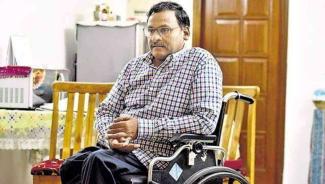Professor GN Saibaba breathed his last at thirty-six past eight in the evening on 12 October 2024. His heart had stopped functioning and doctors were trying desperately to revive him, but it was not to be. Saibaba was 57 years old. He died due to complications arising after the removal of gallstones – a procedure that is seldom life-threatening. But Saibaba did not enter the operation theatre under normal circumstances.
Saibaba’s body – 90% disabled – had been further weakened by a decade of unjust imprisonment under extremely harsh and torturous conditions. Unlike fellow political prisoners Father Stan Swamy, Pandu Narote and Jiya Lal, Saibaba did not die in custody. But there can be no doubt that the ravages of imprisonment hastened his death. Before we delve into the details of how the criminal justice system was utilised to brutalise his body, let’s recall how the state felt threatened by the mind that his disabled body encased. Saibaba, a former Delhi University professor, was arrested along with five others under Section 18 of the Unlawful Activities (Prevention) Act, 1967, alongside other criminal provisions in 2014, for “conspiring to wage war against the government”. His “Maoist links” were also brought up quite often. His real “crime” was that he had openly opposed Operation Green Hunt and other measures, had advocated the causes of Dalits and Adivasis facing state repression, as well as that of suppressed nationalities within India.
Since the Bharatiya Janata Party’s (BJP) rise to power in 2014, the list of people – ranging from human rights activists to lawyers, and journalists to students – being persecuted for their fidelity to fighting for democratic and progressive rights, has grown rapidly. Starting from the arrests related to Bhima Koregaon in 2018 and protests against CAA in 2020 to the arrests of activist Teesta Setalvad and journalist Mohammad Zubair, the current regime is bent on imprisoning any person who speaks truth to power and exposes the lies and misdeeds of the powerful. The draconian Unlawful Activities (Prevention) Act, (UAPA) 1967, under which bail is a rare possibility and jail is the rule, has emerged as the most convenient stratagem to silence such voices. The use of the “Maoist” label has also been quite frequent.
GN Saibaba was arrested just prior to the BJP’s rise to power – in May 2014 – in connection with two other arrests in 2013 (Prashant Rahi and Hem Mishra). Their arrests were a sign of creeping authoritarianism in the years prior to the BJP’s rise: a process which presaged and facilitated the Hindutva ascendancy. Indeed, while the UAPA has been in force since 1967, the Parliament inserted a chapter dedicated to punishing terrorist activities only in 2004 by way of the UAPA Amendment Act, 2004. The law was passed under the Congress-led United Progressive Alliance (UPA) government, which came to power in 2004, and became increasingly more draconian through substantial amendments in 2004, 2008 and 2013. Once imprisoned under UAPA, GN Saibaba’s body and mind faced the entire might of the criminal justice system. The state spared no efforts to keep him in prison for as long as possible, and under as brutal conditions as possible.
He was finally freed in March 2024, when the Nagpur Bench of the Bombay High Court once again acquitted G.N. Saibaba and all the other 5 accused (one of whom died from Swine flu during imprisonment), citing “dodgy” evidence and lack of technical regularity during the prosecution. The state tried again to stall his release but was not successful this time.
The act of destruction of Saibaba’s body was slow and steady. As various illnesses afflicted him in the harsh conditions of prison, he had to be taken to the Nagpur government hospital multiple times in the last few years. Even the doctors requested that he be taken out of jail, but those requests were ignored. In August 2022, he got a severe continuous fever. Because of that, he became susceptible to COVID also. COVID negatively impacted his health, he continuously caught cold and fever, he would fall unconscious suddenly, and have blackouts.
Saibaba was subjected to solitary confinement in the infamous “anda cell” – a chilly cell with high barracks and an egg-shaped window near the roof through which the winter night’s cold air blew in harshly. By the time he was released, Saibaba’s body has become vulnerable to minor ailments, which hastened his passing.
Professor GN Saibaba’s martyrdom re-emphasizes the necessity to question the validity of laws like UAPA in a democratic country, to stop the misuse of the criminal justice system by any government to quell dissent, to push for the bail and speedy trial of all political prisoners, and to strengthen the resistance against a government that wished to eliminate aspirations of justice for all. How just is a justice system that uses the process to punish? Even if a person is acquitted at the end of a long politically motivated proceeding, how long is too long by constitutional and democratic standards? This question must bother us all.
-Akash Bhattacharya









